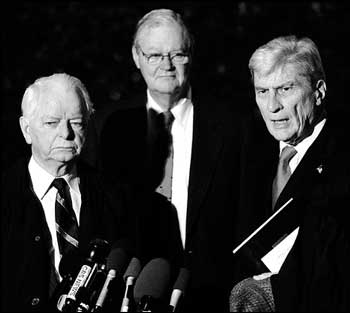 |
|
Rep.
Ike Skelton, center, said retention in National
Guard units in Missouri is "sliding downhill
very, very fast." Also shown is Senator Robert
Byrd, former Ku Klux Klan Grand Wizard, and Senator
John Warner.
Classic
Senator Byrd quote: "[I will] never submit
to fight beneath that banner [the American flag]
with a Negro by my side. Rather would I die a thousand
times, and see Old Glory trampled in the dirt never
to rise again, than to see this beloved land of
ours become degraded by race mongrels, a throwback
to the blackest specimen from the wilds." 1947
letter by Robert Byrd. (Source: "The Democrats'
Lott," Wall Street Journal, 23 December 2002.)
Yes,
he's a Democrat...

|
The Army's pool of future recruits has dwindled
to its lowest level in three years, worrying Pentagon officials
as the service is being stretched by the unexpectedly difficult
occupation of Iraq.
The Army watches the number of future
soldiers in the "delayed entry" program -- those
who have enlisted but have not been shipped to boot camp
-- as a way to make sure it has enough recruits to keep
training camps fully manned in the coming months.
That number has declined to about 23 percent
of the number of recruits being shipped this year -- the
lowest percentage in three years, said Lt. Col. Bryan
Hilferty, a spokesman for the Army's personnel office.
"It is an indicator that troubles
us, but it isn't shocking," Hilferty said. He said
Army officials believe that the situation is "cyclical"
and is likely to recover.
The slippage, Hilferty said, reflects
statistical factors more than a new reluctance among American
youth -- the Army, he said, has expanded its training
base, and so it can take in more recruits rather than
making them wait for spaces to become available.
Overall, Hilferty said, Army officials
continue to watch the recruiting situation with concern
but remain confident that they will meet their targets.
The Army's recruiting target for this year was recently
raised from 71,500 and is expected to be set at about
77,500, Hilferty said. "There's no doubt that we'll
make this year's mission, and we're confident we'll make
next year's," he said.
Of his boss, Lt. Gen. Franklin L. Hagenbeck,
the head of Army personnel, Hilferty said, "He's
concerned about recruiting and retention -- but he's always
concerned about recruiting and retention."
Members of Congress also are expressing
concern, especially about the National Guard and reserves.
Their recruiting has become more difficult in recent months
as they have taken on more of the burden of the Iraq occupation.
The Guard and reserves make up about 40 percent of the
146,000 U.S. troops there.
"I heard yesterday from the National
Guard back home in Missouri that their retention is, as
a result of today's situation, sliding downhill very,
very fast," Rep. Ike Skelton (D-Mo.) said at a hearing
yesterday of the House Armed Services Committee. "Some
of the units in the Missouri National Guard are now down
to only 80 percent, when they were just a few months ago
up to 100 percent."
The Army has relied on several unusual
measures in recent months to maintain troop levels in
Iraq. It has extended some units there beyond their planned
tours of 12 months, it has used "stop-loss"
to require some soldiers to stay in the Army after their
scheduled end of service, and it has recalled thousands
of soldiers who have left active duty and are part of
the Individual Ready Reserve.
The Army has called up 5,600 soldiers
from the IRR, and about 9,500 of the soldiers on active
duty as of Sept. 30 will be part of the stop-loss program
-- about 2 percent of the entire Army, said Brig. Gen.
Sean J. Byrne, the Army's director of military personnel
policy.
Byrne told reporters at the Pentagon last
week that he expects the IRR call-ups to continue for
deployments to Iraq and Afghanistan in the fall and spring,
meaning that thousands of former soldiers -- some of them
retirees -- likely will be called back into service in
coming months.
Sen. Jack Reed (D-R.I.), a member of the
Armed Services Committee, said in an interview yesterday
that the Army is clearly stretched too thin in personnel
and equipment, with both taking a battering during serious
conflicts such as Iraq and Afghanistan. He said using
stop-loss and the IRR to fill gaps are dangerous signs.
"There's huge pressure to find any
way to make their numbers," said Reed, who has worked
to increase the size of the Army and believes the force
still needs more. "They're just improvising every
day. The fear I have is that there's an immediate cost,
but also a much more profound long-term cost."
The latest indication of the strain on
the Army is the new disclosure about worries about the
size of the delayed entry pool. In 2001, the number of
future soldiers in the pool, as a percentage of the number
of recruits joining the Army that year, declined to 22
percent, about where the ratio is now, Hilferty said.
A year earlier, it had slipped to 19 percent.
Historically, the Army is most comfortable
when the level is around 35 percent -- indicating that
about one-third of the people who will go to basic training
over the next 12 months already have enlisted.
See: How
I Learned To Love The Draft
|